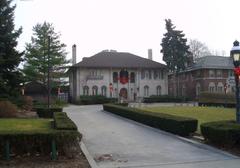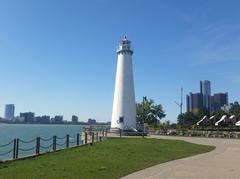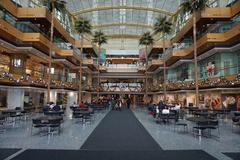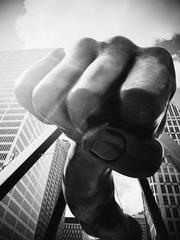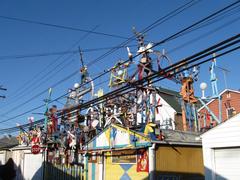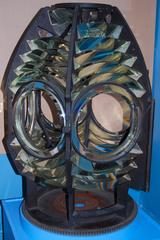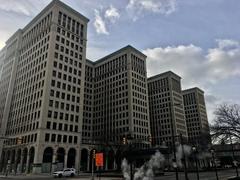
Visiting Manoogian Mansion: History, Tickets, and Tips
Date: 18/08/2024
Introduction
Welcome to the Manoogian Mansion, a monumental piece of Detroit’s vibrant history and architectural splendor. Nestled at 9240 Dwight Street, this Mediterranean Revival-Spanish Colonial Revival style mansion is a testament to the city’s rich cultural heritage and civic pride. Originally built in 1928 at a staggering cost of $300,000, the mansion’s early years were marked by the economic highs and lows of the Roaring Twenties and the Great Depression (Michigan Chronicle). In 1939, the mansion found a new owner in Alex Manoogian, an Armenian immigrant and founder of the Masco Corporation, who purchased it for $25,000 at an auction. Manoogian’s transformative vision for the mansion culminated in its donation to the City of Detroit in 1965, making it the official residence of the city’s mayor by 1966 (Michigan Chronicle).
The mansion’s grand architecture, historical significance, and picturesque location by the Detroit River have made it a focal point for both civic and social events. It has hosted numerous dignitaries, including President Gerald Ford during the World Economic Summit of 1974, and even served as the venue for the wedding of renowned recording artist Gladys Knight in 1975 (Michigan Chronicle). Despite its illustrious history, the mansion has not been without controversy, most notably the unproven but persistent rumors surrounding a scandalous party in 2002 involving then-Mayor Kwame Kilpatrick (MLive).
Today, the Manoogian Mansion stands as a symbol of Detroit’s resilience and generosity, continuing to host a variety of community events and official functions. Its beautifully landscaped gardens and stunning views make it a must-visit destination for anyone interested in the architectural and historical fabric of Detroit.
Table of Contents
- Introduction
- History of Manoogian Mansion
- Visitor Information
- Travel Tips and Nearby Attractions
- Special Events and Photographic Spots
- FAQ
- Conclusion
History of Manoogian Mansion
Origins and Early Years
The Manoogian Mansion, located at 9240 Dwight Street in Detroit, Michigan, is a significant historical residence with a rich past. Constructed in 1928 at a cost of $300,000, the mansion was initially owned by a private individual who unfortunately lost the property during the Great Depression. The house remained vacant until 1939 when Alex Manoogian, an Armenian immigrant and founder of the Masco Corporation, purchased it at an auction for $25,000 (Michigan Chronicle).
Alex Manoogian’s Contribution
Alex Manoogian’s acquisition of the mansion marked the beginning of its transformation into a symbol of civic pride. Manoogian, who had found considerable success in Detroit as an engineer, businessman, and philanthropist, decided to donate the mansion to the City of Detroit in 1965. This generous act was a way for Manoogian to express his gratitude to the city that had provided him with numerous opportunities (Michigan Chronicle).
Becoming the Mayor’s Residence
In early 1966, the Detroit Common Council voted to accept Manoogian’s donation and designated the mansion as the official residence of the Mayor of Detroit. This decision was not only a testament to Manoogian’s generosity but also a strategic move to provide the city’s mayor with a prestigious residence that could be used to host important events and dignitaries (Michigan Chronicle).
Renovations and Upgrades
Over the years, the Manoogian Mansion has undergone several renovations to maintain its grandeur and functionality. These updates have ensured that the mansion remains a valuable asset for the city, providing a suitable venue for official functions and a residence that reflects the city’s pride and heritage. The most recent renovations have been praised for their quality and have contributed to the mansion’s status as a beautiful and useful amenity for the City of Detroit (Michigan Chronicle).
Historical Events and Notable Occasions
The Manoogian Mansion has been the site of numerous significant events, particularly during the tenure of Mayor Coleman Young. In 1974, when Detroit hosted the World Economic Summit, Mayor Young used the mansion to entertain foreign dignitaries, including a notable reception co-hosted with President Gerald Ford. The mansion’s picturesque setting, with its views of the Detroit River and manicured grounds, made it an ideal location for such high-profile gatherings (Michigan Chronicle).
One of the most famous events held at the mansion was the wedding of recording artist Gladys Knight to Barry Hankerson in 1975. Hankerson was working for Mayor Young at the time, and the ceremony added to the mansion’s reputation as a venue for significant social events (Michigan Chronicle).
The Manoogian Mansion Party Controversy
Despite its storied history, the Manoogian Mansion is also known for a scandal that has become part of Detroit’s urban lore. In 2002, rumors surfaced about a wild party at the mansion involving then-Mayor Kwame Kilpatrick, his wife Carlita, and a stripper named “Strawberry.” According to the legend, Carlita Kilpatrick allegedly attacked the stripper after witnessing her giving the mayor a lap dance. Although the party’s existence was never proven, the controversy had a lasting impact on Kilpatrick’s career (MLive).
Investigative reporter M.L. Elrick, who helped uncover the text-message scandal that led to Kilpatrick’s resignation, stated that there was no concrete evidence to support the party’s occurrence. Nonetheless, the story persisted and became a part of the mansion’s complex history (MLive).
Cultural and Civic Significance
The Manoogian Mansion’s role as the mayor’s residence has made it a focal point for the city’s cultural and civic activities. It has been used to host a variety of events, from official receptions to community gatherings, thereby fostering a sense of unity and pride among Detroit’s residents. The mansion’s history as a community place, as noted by Ken Coleman, underscores its importance as a symbol of the city’s resilience and generosity (Michigan Chronicle).
Visitor Information
To make your visit to the Manoogian Mansion enjoyable, please note the following details:
- Visiting Hours: The mansion is open to the public from Tuesday to Sunday, 10 AM to 4 PM.
- Tickets: General admission tickets are priced at $10 for adults, $5 for seniors and students, and free for children under 5. Tickets can be purchased online or at the entrance.
- Guided Tours: Guided tours are available at 11 AM, 1 PM, and 3 PM daily. These tours provide in-depth historical context and access to areas not available on self-guided tours.
Travel Tips and Nearby Attractions
- Travel Tips: The Manoogian Mansion is located in a residential area with limited parking, so it’s advisable to use public transport or ride-sharing services. Wear comfortable shoes as the tour involves walking.
- Nearby Attractions: While in Detroit, consider visiting other historical sites such as the Detroit Institute of Arts, Motown Museum, and Belle Isle Park. These attractions offer a comprehensive view of the city’s rich cultural heritage.
Special Events and Photographic Spots
The Manoogian Mansion hosts various special events throughout the year, including art exhibitions, historical lectures, and community gatherings. Check the official website for the latest event schedule.
For photography enthusiasts, the mansion’s beautifully landscaped gardens and the stunning views of the Detroit River provide perfect backdrops for memorable photos.
FAQ
Q: Are there any restrictions on photography inside the mansion? A: Photography is allowed in designated areas only. Flash photography and tripods are not permitted.
Q: Is the mansion wheelchair accessible? A: Yes, the Manoogian Mansion is fully accessible to visitors with mobility issues.
Conclusion
The Manoogian Mansion encapsulates Detroit’s architectural grandeur, historical depth, and civic spirit. From its origins in the late 1920s to its current status as the official residence of the city’s mayor, the mansion has witnessed and contributed to many significant moments in Detroit’s history. Its Mediterranean Revival-Spanish Colonial Revival architecture, lavish interiors, and meticulously landscaped grounds offer a unique glimpse into the opulence and grandeur of a bygone era, while its role in contemporary civic life continues to foster community pride and unity (Michigan Chronicle). Visitors can explore its rich past through guided tours, special events, and community gatherings, making it a focal point for both historical education and cultural celebration.
Despite its enduring beauty and significance, the Manoogian Mansion is also a reminder of the complexities and challenges that come with preserving historical landmarks. From the various renovations and upgrades to the scandals that have occasionally marred its reputation, the mansion’s story is one of resilience and transformation. Organizations like the Manoogian Mansion Restoration Society play a crucial role in maintaining its historical and architectural integrity, ensuring that future generations can continue to appreciate this iconic landmark (Manoogian Mansion Restoration Society).
In summary, visiting the Manoogian Mansion offers a multifaceted experience that combines architectural beauty, historical intrigue, and cultural significance. It stands as a testament to the rich tapestry of Detroit’s heritage, making it a must-visit for locals and tourists alike. For the latest updates and more information, download the Audiala mobile app, check out related posts, and follow us on social media.
References
- Michigan Chronicle, n.d., ‘History of Manoogian Mansion’ Michigan Chronicle
- MLive, 2013, ‘Kwame scandal flashback: the Manoogian Mansion party’ MLive
- Manoogian Mansion Restoration Society, n.d., ‘Manoogian Mansion Restoration Society’ Manoogian Mansion Restoration Society
- Armenian Weekly, 2024, ‘July’s Detroit Armenia Fest to honor Manoogian Manor’ Armenian Weekly
- Triphobo, n.d., ‘Manoogian Mansion visitor information’ Triphobo
